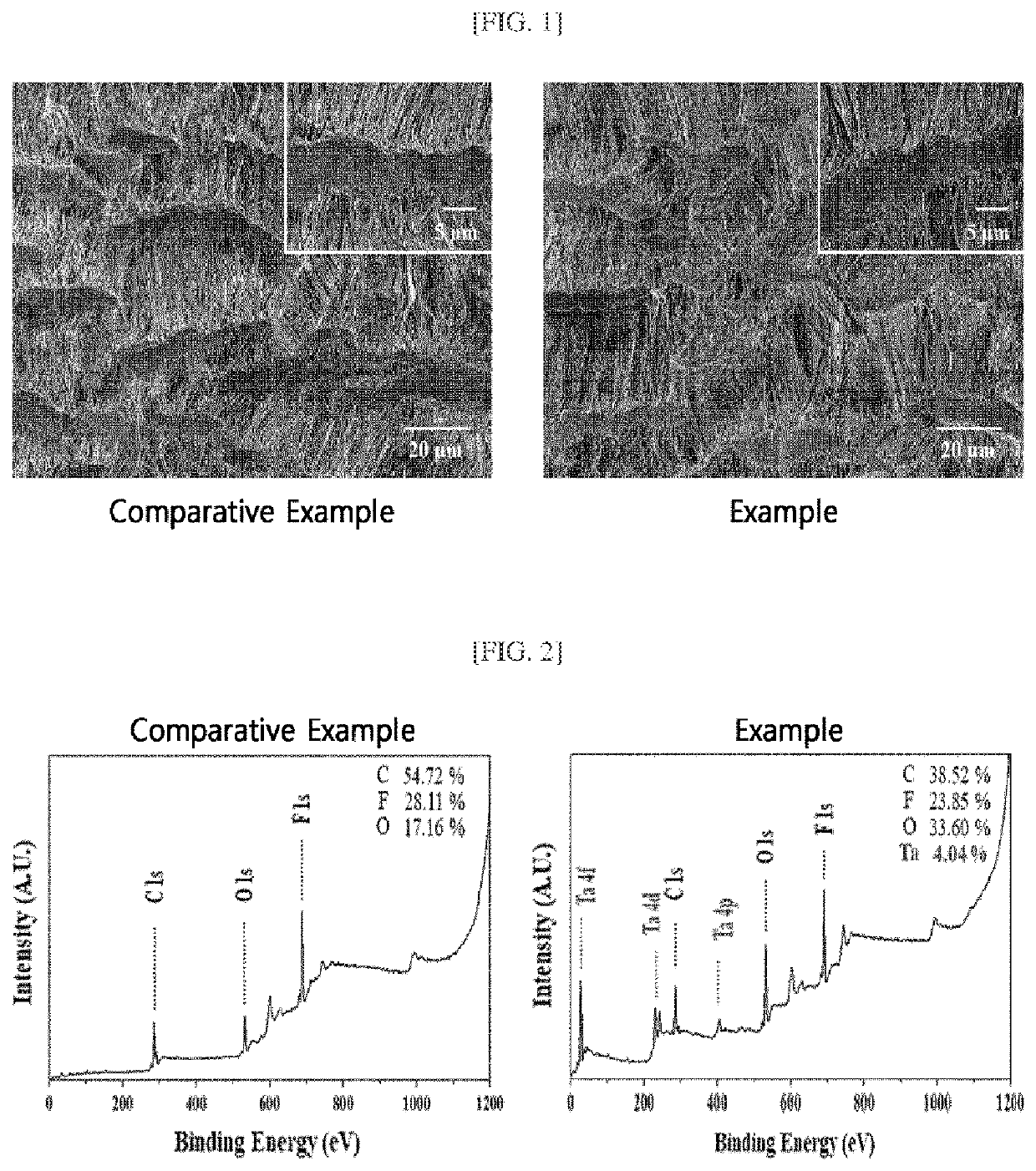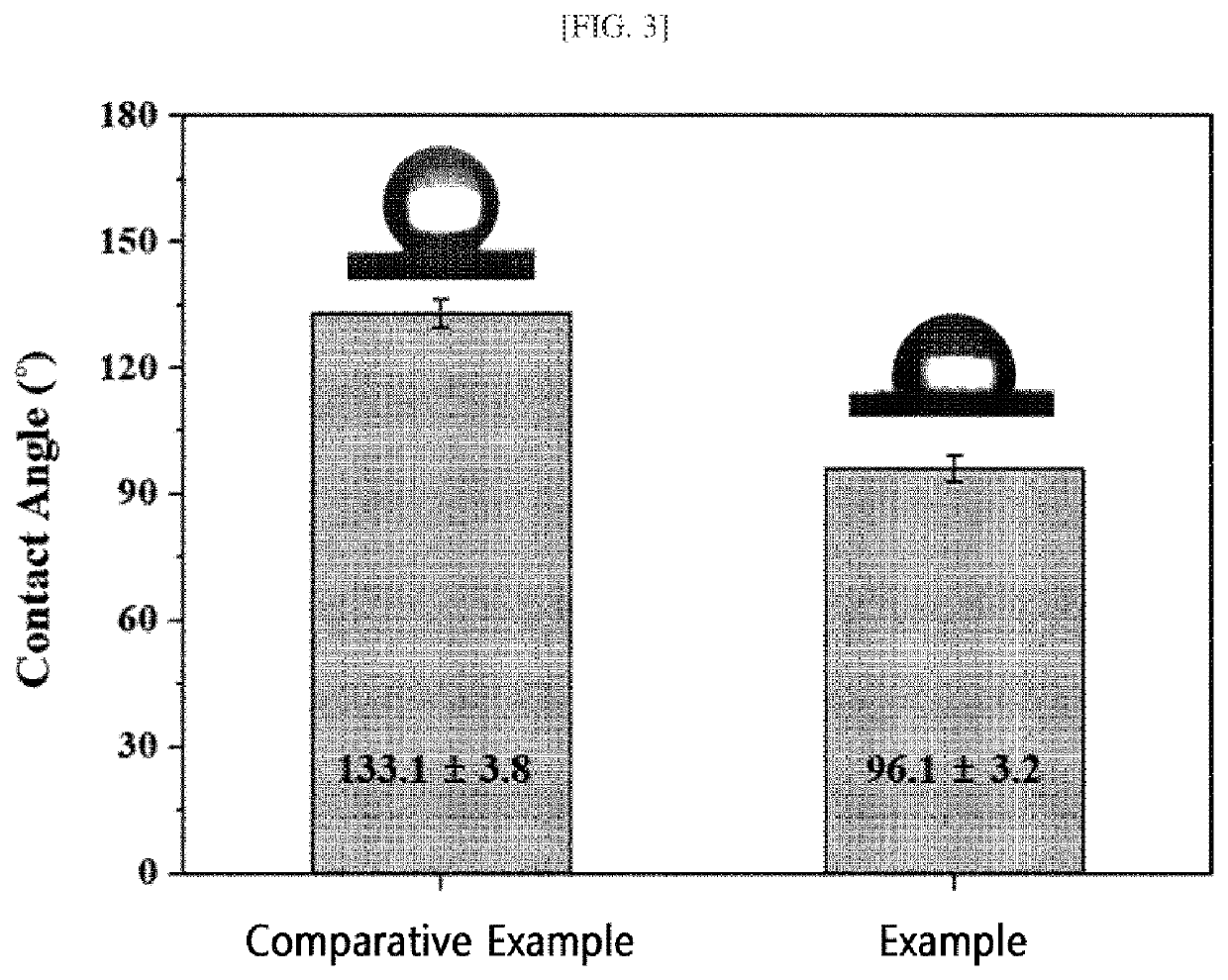METHOD OF MANUFACTURING ePTFE ARTIFICIAL VASCULAR GRAFT WITH IMPROVED BLOOD COMPATIBILITY BY SELECTIVE PLASMA ETCHING
- Summary
- Abstract
- Description
- Claims
- Application Information
AI Technical Summary
Benefits of technology
Problems solved by technology
Method used
Image
Examples
example 1
on of ePTFE Having Surface Treated by Way of Selective Plasma Etching
[0045]In order to implant ions of tantalum as a bioactive metal into the surface of the ePTFE specimen prepared in the size of 10 mm×10 mm according to Comparative Example 1 by way of selective plasma etching, the ePTFE specimen and the tantalum target were positioned in the vacuum chamber of a DC magnetron sputter to be spaced about 15 cm apart from each other, and then argon gas as a sputtering gas was introduced to form a plasma in the chamber, and the degree of vacuum was formed to a level of about 10−2 Torr. Thereafter, a negative voltage was applied to the tantalum target (purity of 99.99%) to form a plasma inside the vacuum chamber, and at the same time, a higher negative voltage was applied to the fixing plate on which the ePTFE specimen was placed to form a potential difference between the target and the fixing plate. The tantalum ions accelerated to the fixing plate by electrical attraction due to the pot...
experimental example 1
in Surface Structure of Tantalum Ion-Implanted ePTFE Having Surface Treated by Way of Selective Plasma Etching
[0046]In order to confirm the changes in surface structure of ePTFE before (Comparative Example) and after (Example) subjected to the surface treatment by way of selective plasma etching according to the present invention, the surface structure of ePTFE was observed under a field emission-scanning electron microscope (FE-SEM), and the results are illustrated in FIG. 1. As illustrated in FIG. 1, it has been confirmed from the high-magnification images of the Comparative Example and Example that the porous pore structure of untreated ePTFE is stably maintained without any change in the surface structure due to the surface treatment by way of selective plasma etching.
Experimental Example 2: Identification of Chemical Structure on Tantalum Ion-Implanted ePTFE Surface Treated by Way of Selective Plasma Etching
[0047]In order to identify the changes in chemical species on the surfa...
experimental example 3
hilicity of Tantalum Ion-Implanted ePTFE Surface Treated by Way of Selective Plasma Etching
[0048]In order to confirm the changes in properties of the ePTFE surface according to the surface treatment by way of selective plasma etching, hydrophilicity, a representative surface property of polymer substrates, was confirmed. Specifically, the water contact angle on the tantalum-implanted surface of the samples of Comparative Example 1 and Example 1 was measured, and the results are illustrated in FIG. 3. As illustrated in FIG. 3, the Comparative Example, which was an untreated ePTFE specimen, was confirmed to be highly hydrophobic, having a significantly high water contact angle of about 133°, but the Example, which was an ePTFE specimen into which tantalum ions were implanted by way of selective plasma etching, had a significantly decreased water contact angle of about 96°. This indicated that hydrophilicity had been imparted to the hydrophobic ePTFE surface through the surface treatme...
PUM
| Property | Measurement | Unit |
|---|---|---|
| Length | aaaaa | aaaaa |
| Length | aaaaa | aaaaa |
| Electric potential / voltage | aaaaa | aaaaa |
Abstract
Description
Claims
Application Information
 Login to View More
Login to View More - R&D
- Intellectual Property
- Life Sciences
- Materials
- Tech Scout
- Unparalleled Data Quality
- Higher Quality Content
- 60% Fewer Hallucinations
Browse by: Latest US Patents, China's latest patents, Technical Efficacy Thesaurus, Application Domain, Technology Topic, Popular Technical Reports.
© 2025 PatSnap. All rights reserved.Legal|Privacy policy|Modern Slavery Act Transparency Statement|Sitemap|About US| Contact US: help@patsnap.com



